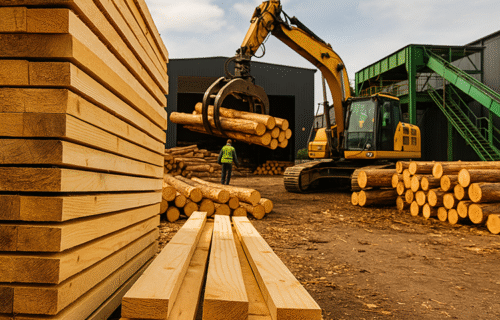Forests stretch across much of Central Europe, shaping not only its landscapes but also its economies. In Poland and the Czech Republic, the timber industry remains an essential part of national growth, providing raw material for furniture, construction, and paper production. Yet behind this success lies a quieter argument — one about how much wood should be harvested, how forests are renewed, and who gets to decide.
Poland’s forest management system is often presented as a model of efficiency. The state enterprise Lasy Państwowe oversees most of the country’s woodland, replanting hundreds of millions of trees each year and keeping forest cover on a slow upward trend. Timber output has supported one of Europe’s strongest wood-processing sectors, which now employs tens of thousands of people.
But within this success story, disagreements are growing. On one side, companies that depend on steady timber supplies fear that recent proposals to reduce harvest levels could weaken an industry built on long-term stability. For them, sustainable forestry should still include strong economic output and job protection.
On the other side, environmental specialists and conservationists question whether forest management has become too focused on production. They say that key decisions are made by state authorities with little room for local voices or public oversight. Some critics also point to conflicts in protected areas, arguing that biodiversity and climate priorities should take precedence over timber sales.
Behind these disputes is a larger question: can Poland continue to grow its wood-based economy while also aligning with European climate and conservation goals? The answer may depend on whether future policies can give equal weight to ecological and economic value.
In the Czech Republic, years of emergency logging triggered by the bark beetle outbreak left visible scars on the landscape. Forests once dominated by spruce monocultures are now being replanted with a broader mix of species to make them more resilient to drought and disease. The recovery effort has become a turning point in how the country thinks about forestry.
Experts and forest managers now speak of renewal rather than production. There is growing emphasis on natural regeneration and the ecological functions that forests provide — from filtering water to moderating heatwaves. Many professionals believe that restoring balance between nature and economy is the key lesson from the crisis.
Still, not everyone agrees on how far this shift should go. Some industry representatives warn that the rapid expansion of broadleaf species could reduce the long-term supply of commercially valuable wood, while environmental advocates argue that the new diversity is essential to prevent another large-scale die-off.
Small forest owners and local cooperatives have also entered the debate. They see local management as a way to adapt forests more quickly to changing conditions, while large-scale state policies can be slow to respond. Across the country, the conversation has moved from how to harvest more to how to make forests more adaptable to future stress.
Despite their different experiences, Poland and the Czech Republic face a common dilemma: how to balance their reliance on wood-based industries with the ecological limits of their forests.
Both countries have made progress in replanting harvested areas and expanding forest cover. Yet they also face growing scrutiny over transparency, local participation, and the role of forests in climate policy. For many observers, the debate is no longer just about how much timber is cut each year, but about how societies define responsible use of natural resources.
In both Warsaw and Prague, officials insist that forest management remains sustainable. But as environmental pressures mount and public awareness deepens, the measure of success may shift — from production figures to the resilience of the forests themselves.
Source: CIJ EUROPE synthesis based on data and reports from Lasy Państwowe, Lesy ČR, Statistics Poland, Czech Statistical Office, UNECE, FAO, and national forestry studies (2023–2025).
